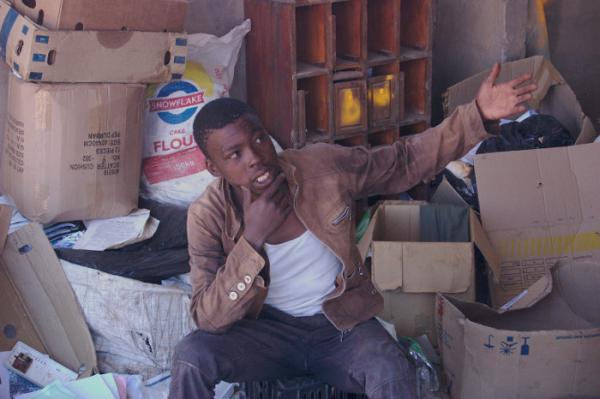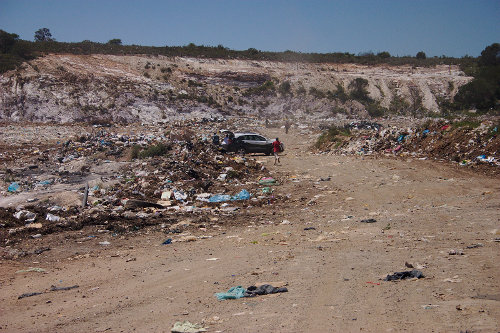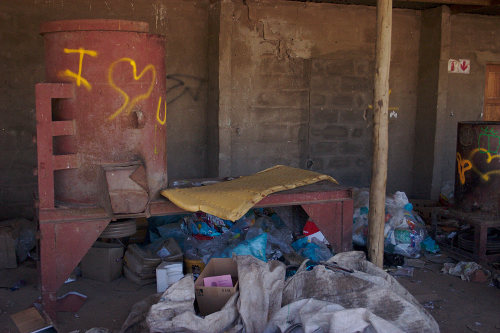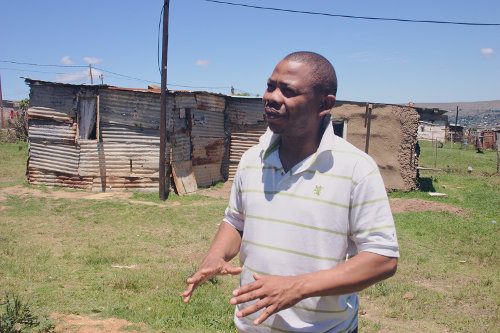

Siyabonga Radebe. Photo by Jon Pienaar.
20 November 2013
On the edge of the university hamlet of Grahamstown, there’s a municipal dump where people discard trash. It’s far enough out of town to not smell the stench – or for most locals not to be reminded of the haunting plight of the poor who subsist off the waste.
In the dry heat of Grahamstown you can smell the rubbish dump long before you can see it. Discarded packaging, bits of plastic and other waste latch onto the grass on the side of the sand road that leads up to this place where the university town says goodbye to its trash.
Driving into the municipal dump, it is hard to appreciate the full extent of the site because the first thing one notices is youths rushing one’s car. The haste is to be the first to acquire anything of value that can be exchanged for a couple of rand, or to get at food.
The word ‘food’ is used euphemistically here, because what’s dropped at Grahamstown’s municipal dump is mostly rancid. But the handful of young men who live at the Makana Municipal dump depend on the garbage to try and eke out an existence.

Youths running after a car. Photo by Jon Pienaar.
It is here that I meet Siyabonga Radebe. He’s about 23 years old now, and has been living on or near the dump since his early teens.
Today, Radebe isn’t one of those who runs after cars for food or recyclables. He hangs back under a large shed that is a roof and no walls. His eyes are bloodshot and he’s coughing – it’s a deep, hacking cough. “I’ve been here since 2000, and now I live here in this shed,” says Radebe who speaks Xhosa which is translated by Ayanda Kota, the founder of the Unemployed People’s Movement.
“There were shacks here near the dump. I came from Port Elizabeth to be with my mother because she was terminal. She died in 2005. The shacks were then demolished and I had nowhere to go. I used to study but I left school. I have no one to support me, I have no family. My father is dead and after our shacks were destroyed I came to live here.”

Siyabonga Radebe’s bed. Photo by Jon Pienaar.
Radebe says that he left school after doing Grade 6.
“We eat when the cars come and they dump. People also dump wires or metal or boxes. We sort the boxes and the wires. You can get R13 for this,” he says pointing to a box of what looks like old computer wires. The box is about the size of an apple box.
In Grahamstown, impoverished locals have been living off the municipal dump for decades.
As a journalism student at Rhodes University some thirty years ago, a film project that got top honours from the Department of Journalism & Media Studies at the time was a short documentary about township women who ‘ate’ from refuse discarded at the apartheid government’s refuse site.
The dawn of democracy hasn’t changed living conditions for people forced to live off trash in the Eastern Cape town. In 2010 Thembeni Plaatjie wrote an article for The Grocott’s Mail titled: Scavengers survive on Municipal dump site waste. Plaatjie’s story relays how she saw streams of “dirt poor” Grahamstonians carrying “big plastic bags filled with cans, food tins, clothing, books, electronic appliances, vegetable peels, bread and even raw fish” from the dumping ground.
The word ‘food’ is used euphemistically here, because what’s dropped at Grahamstown’s municipal dump is mostly rancid.
The article cites 50-year-old Phindile Makhasi from a nearby informal settlement who said he had to risk his life to get food. “When a waste truck offloads its load, we all run there in an effort to sort out bits of scrap food. It’s tough, but we’ve got no choice, there are no jobs. I live with my son and four children, and my health is not good. We are feeding and dressing our children from the dump. Some of the things we get them here are healthy for consumption and we therefore see no problem eating or dressing them. We sometimes sell the things we find here to the residents in the township,” he told the journalist.
Another resident of an informal settlement, Nyanisile Bonani, told Grocott’s Mail about his anger at those learned people of Grahamstown who don’t care about locals who live off the dump. “The educated people don’t have a heart, they don’t feel for their brothers and sisters. They sometimes come here and collect people to do occasional jobs at their homes and pay them R5 for a four hour job. What is that?”, asked Bonani before adding, “they only think about themselves.”
The Makana Municipality’s perspective is that people at the site are trespassers and that the discarded food waste is not fit for human consumption. Back at the municipal site, Radebe’s hacking cough causes a break in our conversation. He insists, “No I am not sick,” between bouts of coughing. “But I could have TB because of the conditions we live in. I am coughing up blood. I don’t know. There is my mattress.” The young man points to a thin piece of bare foam. “We use these things to cover ourselves at the night,” he adds pointing to cardboard boxes.
As Radebe speaks, the other youths look at him. Visibly, they appear much fitter and more agile than he is. Their clothes aren’t as dirty and threadbare. There’s something different about Radebe – a palpable pain. It is very evident that he is hurting, badly. This could be an emotional state given the profound grief and loss he faces. It could be the physical pain of coughing up blood, or weight of the shear struggle for survival. Perhaps it is the effect of years of hopelessness.
Pedro Tabensky, a philosophy professor at Rhodes University, talks about the experience of hopelessness that exists amongst the destitute of Grahamstown, situated in one of the poorest provinces of South Africa. “[T]he broken lives that are the result of hopelessness are richly present among the poor today,” wrote Tabensky in a piece called Rebellion against hopelessness published in the Daily Dispatch a couple of years ago.
He explains that millions of South Africans live in conditions so dire that it makes it extremely difficult for them to have faith in the future. “If one loses all hope in hopeless circumstances, suicide is a clear way out. If one largely replaces faith in the future with wishful thinking, with fantasy formations founded on anxiety-avoiding protective fictions, then one is on the way to madness. And if one chooses to stop reflecting altogether about one’s condition and comes to live for the sake of raw survival alone, one’s life becomes almost indistinguishable from those of beasts. These three alternatives to hope are strikingly present among the poor today.”
Tabensky adds that hope can be restored through collective action by the poor. “Social rebellion is fuelled by a special kind of hope – a collective hope for a better tomorrow that can only be brought about by the concerted action of those who today are forced to shit in buckets, forced to rot in shacks, forced to live in permanent hunger and forced to remain ignorant and unskilled. Today’s rebellion of the poor is probably the only healthy option for those living under conditions in which only the uniquely strong can hope.”
“I want to escape this life, but how? I think of completing my schooling but why? I have no support. I have no family.”
Sitting in the putrid heat of the dump, Radebe says he has little hope. “I want to escape this life, but how? I think of completing my schooling but why? I have no support. I have no family,” he says. “The only way to survive here in Grahamstown is if you get a job.” But without a matric or identity documents, opportunities for Radebe are scarce.
“I don’t even know who my family is. Who is my aunt? Who are my family members? I have no ID book. I have no birth certificate. And I am losing my memory. I know my mother’s surname is Radebe. My father died before that. I think his surname is Qugenti.”
While Radebe speaks a new car drives into the dump. It has the logo of Pam Golding Properties emblazoned on it. There’s a woman in the car and she drives speedily, way past the youths who are now running toward her. Radebe stays seated and watches. The woman quickly pulls garbage out her car, but the youths have caught up to her. She doesn’t speak to them or acknowledge them. She merely deposits her refuse and then hastens to leave, kicking up sand with her wheels in her wake.
The Unemployed People’s Movement’s Kota watches the woman race off and says: “No one comes with soup or anything else for these kids. There is such an absence of solidarity with those who suffer because of poverty in Grahamstown.”

Ayanda Kota, founder of the Unemployed People’s Movement. Photo by Jon Pienaar.
Silence engulfs the small group of people speaking at the edge of a sprawling municipal dump in Makana. Kota and I shake Radebe’s hand and thank him for his time. He sighs.
As the refuse site disappears in the rear view mirror Kota tells me that these are the people that keep him awake at night. He explains that he is haunted by people – like Radebe - who experience extreme poverty in Grahamstown.
“In the suburbs people are playing golf or riding their horses, but here at the dump these young people live a tortured, terrible existence. Where is the love and compassion for these people?” Kota asks.
Editor’s Note: The Department of Home Affairs has been approached to assist Siyabonga Radebe. They have agreed to help Radebe get an identity document so that he might get access public health and social welfare services. If anyone can help Radebe locate his family or render any further assistance to him, please contact Ayanda Kota by emailing ayandakota [at] gmail.com or by calling Kota on 078 625 6362.
South Africa hasn’t adopted an official means of measuring poverty, such as a poverty line. This makes pegging numbers for a socioeconomic issue that’s difficult to define, even more fraught.
The Eastern Cape Socio Economic Consultative Council (ECSECC) uses UNISA’s BMR poverty line for its research, and this sets a poverty line for all districts in the Eastern Cape at R1,892 per month using 2005 prices.
Using this benchmark ECSECC states: “22 million people living in poverty in South Africa, nearly 3.9 million live in the Eastern Cape. This means that 44% of South Africa’s population and 57% of the province’s population live in poverty.” In Makana, a municipality with a population of some 70,000 people, the number of people living in poverty in 2010 was set at 27,546 or close on 40%.
Download ECSECC’s development indicators for 2012.